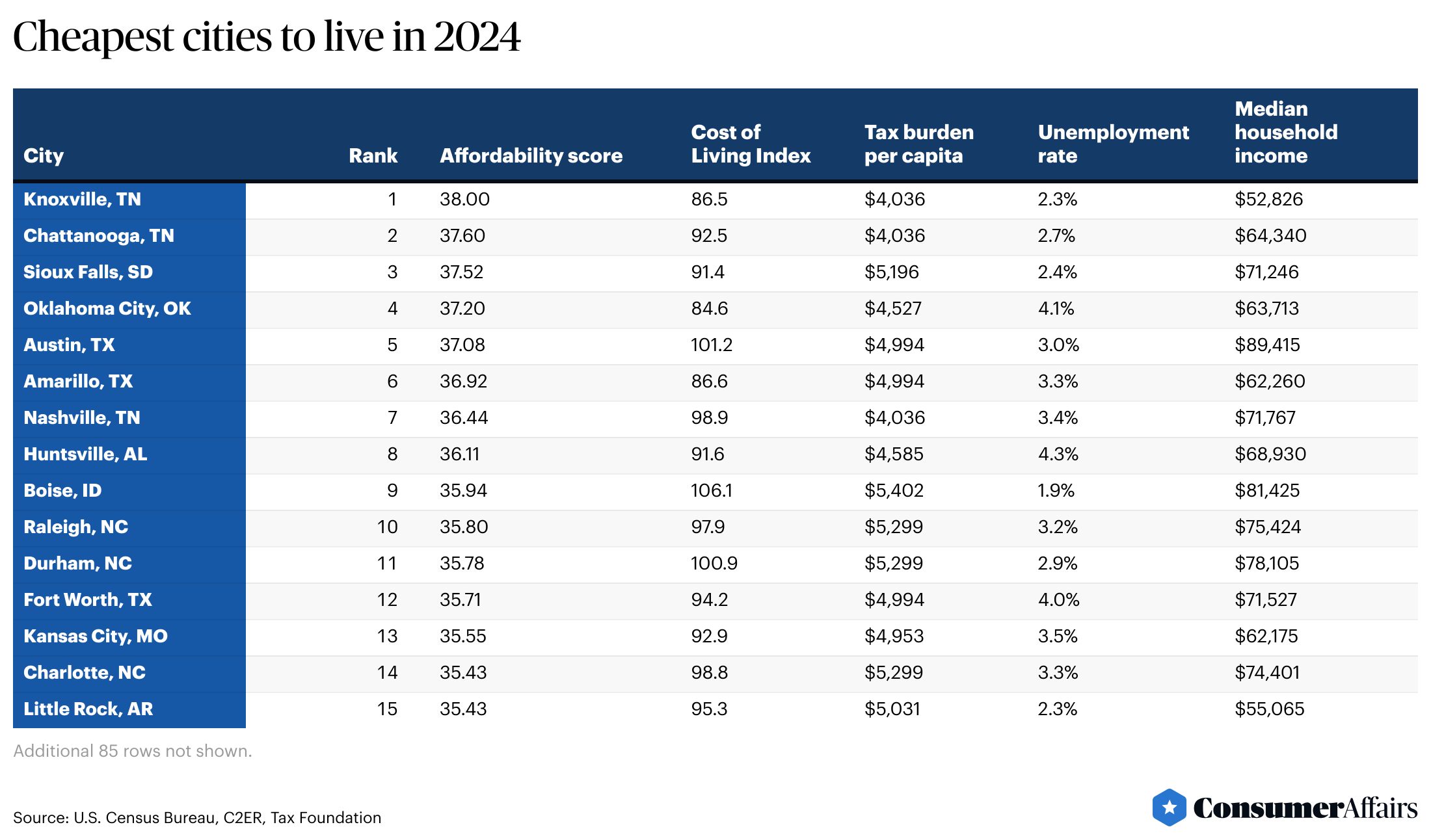Wind: mph,
Welcome to our new web site!
To give our readers a chance to experience all that our new website has to offer, we have made all content freely avaiable, through October 1, 2018.
During this time, print and digital subscribers will not need to log in to view our stories or e-editions.

As the cost of living continues to rise, Americans are looking for ways to save money and live comfortably. A survey by Northwestern Mutual revealed that a third of American adults don't feel financially secure — the highest amount recorded in the study's 12-year history. For many, it's time to make a change.
With a new city comes new opportunities, and moving is an option for anyone trying to make the most of their paychecks. Finding the right moving company is one thing, but determining where to move can be a real challenge with so many options.
The research team at ConsumerAffairs analyzed data from the 100 most populous U.S. cities to determine the most affordable cities in 2024. We pulled data from multiple sources on different factors — including cost of living, income and taxes — to rank the top 10 cheapest cities in the country and help potential movers find the right fit.
Key Insights
ConsumerAffairs weighed four factors to determine the cheapest cities to live in 2024. These include a cost of living index, state and local tax burden per capita, median income and unemployment rate.
The Council for Community and Economic Research's (C2ER) Cost of Living Index uses six different factors: the cost of groceries, housing, utilities, transportation, health care and miscellaneous goods and services. The index's baseline is 100, meaning scores above or below 100 are more or less expensive to live in compared with the national average.
We added separate scores for each of the four factors to get an overall affordability score and rank 100 of the most populous U.S. cities. The index was weighed twice as much as each of the other three factors.
Knoxville's highest affordability score makes it the cheapest city to live in. Its best score is for unemployment, which is about half of the national average. Housing costs in Knoxville are around 73% of the U.S. average, and taxes are low.
Knoxville's affordability score: 38.0
Chattanooga, Tennessee, is ranked close behind Knoxville, finishing as the second-cheapest city on our list. Chattanooga's higher median household income makes up for its comparatively pricer housing costs. With a population of 184,017, it's the smallest city in our top 10 list.
Chattanooga's affordability score: 37.6
Sioux Falls, South Dakota, earned the third spot on our list thanks in large part to its low unemployment rate. It also has low housing and transportation costs. However, its health care costs are above the national average.
Sioux Falls' affordability score: 37.52
Oklahoma City, Oklahoma, has the best Cost of Living Index on our top 10 list, which includes housing costs that are about 33% below the national average. It also has a below-average per capita tax burden and unemployment rate — though median income is on the lower end.
Oklahoma City's affordability score: 37.20
Texas' capital is the largest on our top 10 list in terms of population size (975,335) and has the highest median household income: $89,415. But it also has the highest housing costs, at 15.2% above the national average.
Austin's affordability score: 37.08
Amarillo, Texas, has the cheapest health care costs (14.6% below the national average) and the second-most affordable housing out of the cities on our top 10 list. However, a lower median household income means this second Lone Star State city ranks below Austin.
Amarillo's affordability score: 36.92
Nashville, Tennessee, is the second state capital on our list and the city with the second-most affordable health care. It's the perfect spot to live for fans of country and bluegrass music, and its low taxes make up for slightly pricier grocery and housing costs.
Nashville's affordability score: 36.44
Huntsville, Alabama, is known as "Rocket City" because of its association with the Saturn V rocket, and its U.S. Space & Rocket Center is the largest space museum on Earth. Huntsville's best individual score is for its low tax burden. Health care costs there are the second lowest of any city in the top 10.
Huntsville's affordability score: 36.11
Boise, Idaho, has the lowest unemployment rate (1.9%) of all 100 cities included in our analysis. The city is actively looking for more workers, especially those with trade experience in the construction industry, according to reporting from the Idaho Business Review. Boise has comparatively expensive housing costs and high transportation expenses, but it has low utility costs and the second-highest median household income in our top 10 list.
Boise's affordability score: 35.94
Raleigh, North Carolina, rounds out our list of the top 10 cheapest cities thanks to a median household income slightly higher than the national average and cheaper-than-average grocery and transportation costs. However, its health care cost index score, at 11.7% above the national average, keeps it from ranking any higher. The state's capital city is part of an area known as the Research Triangle, which also includes Chapel Hill and Durham. The universities there — North Carolina State, the University of North Carolina at Chapel Hill and Duke — make it a hub for jobs in the technology industry.
Raleigh's affordability score: 35.80
The 100 cities featured in our analysis are ranked according to the ConsumerAffairs Research Team's affordability score. The affordability score was calculated using the Cost of Living Index from C2ER, income and unemployment data from the U.S. Census Bureau and tax figures from the Tax Foundation.

The rising cost of living doesn't show any signs of stopping. For Americans looking to save money and live a more affordable lifestyle, moving to a new city with a cheaper cost of living could provide some much-needed breathing room and financial flexibility. Whether you want to start a family or pay off student loans, saving every penny counts.
For those looking to move, the decision ultimately comes down to finding a healthy balance between a location you find appealing and the affordability to enjoy what your new city offers.
To compile our list of cheapest cities to live in 2024, the ConsumerAffairs Research Team ranked 100 of the largest U.S. cities by an affordability score, calculated using four metrics:
Each city was scored on each metric based on a normalized scale from 0 to 10, with 10 assigned to the city with the best score. The Cost of Living Index was weighed twice as much as each of the other three metrics. We added the scores together for a final affordability score.
This story was produced by ConsumerAffairs and reviewed and distributed by Stacker Media.